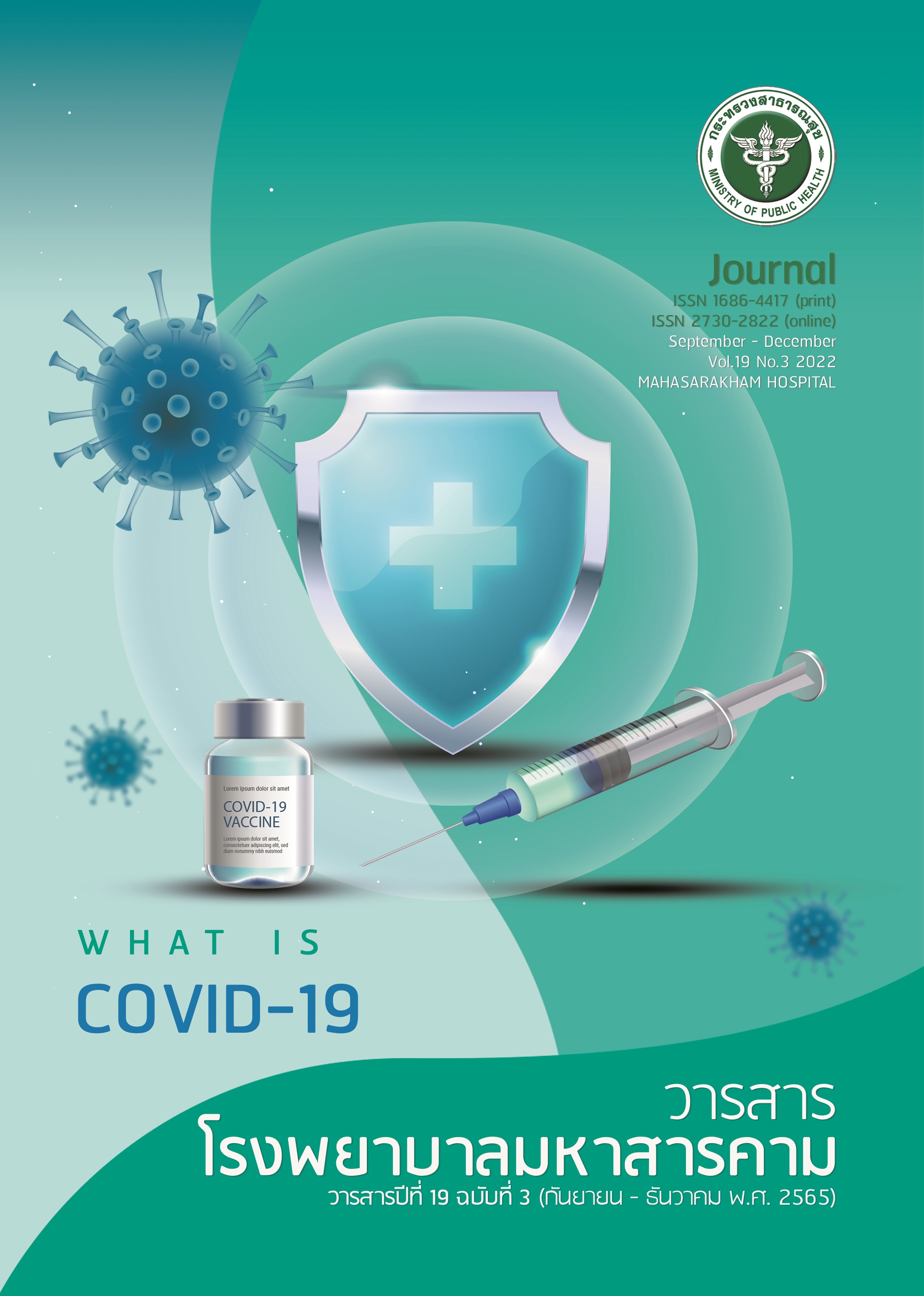ความชุกและปัจจัยที่เกี่ยวข้องกับสุขภาพจิตของบุคลากรโรงพยาบาลมหาสารคาม
คำสำคัญ:
สุขภาพจิต, ภาวะหมดไฟ, ความเครียด, ซึมเศร้า, การฆ่าตัวตาย, บุคลากรในโรงพยาบาลบทคัดย่อ
วัตถุประสงค์ : เพื่อศึกษาอัตราความชุกและปัจจัยที่เกี่ยวข้องกับสุขภาพจิตของบุคลากรโรงพยาบาลมหาสารคาม
รูปแบบและวิธีวิจัย : การศึกษาครั้งนี้เป็นการศึกษารูปแบบเชิงพรรณนาแบบตัดขวาง (Cross-sectional descriptive study) คัดเลือกแบบเจาะจงโดยใช้ข้อมูลทุติยภูมิ (Secondary Data) จากการตรวจสุขภาพประจำปี 2565 ของบุคลากรโรงพยาบาลมหาสารคาม รายงานด้วยตัวเลขจำนวน ร้อยละ ค่าเฉลี่ย และ ค่าเบี่ยงเบนมาตรฐาน รวมถึงหาความสัมพันธ์ระหว่างปัจจัยที่มีผลต่อปัญหาสุขภาพจิตของบุคลากรในประเด็นต่างๆ โดยวิเคราะห์การถดถอยโลจิสติก (Logistic regression analysis) กำหนดระดับนัยสำคัญทางสถิติ p-value<0.05
ผลการศึกษา : บุคลากรโรงพยาบาลมหาสารคามมีอัตราความชุกของปัญหาสุขภาพจิต ซึ่งประกอบด้วยอาการของภาวะหมดไฟ ร้อยละ 63.4 ความเสี่ยงภาวะซึมเศร้า ร้อยละ 15.9 มีความเครียด ในระดับมากถึงมากที่สุด ร้อยละ 3.6 และความเสี่ยงต่อการฆ่าตัวตาย ร้อยละ 1.1 ปัจจัยกลุ่มภารกิจงาน มีความสัมพันธ์และสามารถทำนายอาการภาวะหมดไฟและความเสี่ยงภาวะซึมเศร้าของบุคลากรได้ อีกทั้งพบว่าปัจจัยเรื่องเพศ อายุและประเภทตำแหน่งมีความสัมพันธ์อย่างมีนัยสำคัญทางสถิติและทำนายทิศทางของอาการภาวะหมดไฟของบุคลากรโรงพยาบาลมหาสารคามได้ กล่าวคือกลุ่มภารกิจบริการด้านการพยาบาลและกลุ่มภารกิจบริการทุติยภูมิและตติยภูมิ มีโอกาสที่จะมีความเสี่ยงภาวะซึมเศร้ามากกว่ากลุ่มภารกิจบริการ ปฐมภูมิ 2.67 เท่า (adjusted OR 95% CI; 1.27-5.65) และ 2.87 เท่า (adjusted OR 95% CI; 1.31-6.28) ตามลำดับ
สรุปผลการศึกษา : อัตราความชุกปัญหาสุขภาพจิตของบุคลากรโรงพยาบาลมหาสารคาม พบว่า มีอัตราความชุกของอาการภาวะหมดไฟสูงสุด รองลงมาคือความเสี่ยงภาวะซึมเศร้า ความเครียดและ ความเสี่ยงการฆ่าตัวตายตามลำดับ นอกจากนี้ปัจจัยที่มีความสัมพันธ์กับปัญหาสุขภาพจิตของบุคลากรคือปัจจัยเรื่องกลุ่มภารกิจงาน
เอกสารอ้างอิง
Kanthasorn, W., & Songthap, A. (2018). Factors affecting preventive health risk behaviors from working amongmedical laboratory workers at tertiary hospitals in lower northern Thailand. Journal of Medicine and Health Sciences, 25(1), 22-37.
Saidum, S., & Sriruecha, P. (2009). Organizational Climate Affecting the Pharmacists' Organizational Commitment at the Regional Hospitals in the Northeast. Thai Journal of Pharmacy Practice, 1(1), 71-83.
Thinthalang, K. (2021). Quality of Work Life and Organizational Commitment of Professional Nurses in Community Hospitals in Phuket Province. Region 11 Medical Journal, 35(1), 1-12.
Pholchan, T., & Chuangchum, P. (2018). The life purposes and searching for meaning of life in the Third - Year Medical Students, Naresuan University. Thammasat Medical Journal, 18(4), 636-643.
Chutha, W., kittiratanapaiboon, P., Makkhlai, K., & Tantirangsi, N. (2022). Burnout and related factors in health personnel form the Coronavirus Disease 2019 (COVID-19) pandemic. Journal of Mental Health of Thailand, 30(2), 147-160.
Uthaisang, T. (2021). COVID - 2019: raising morale and morale for healthcare workers. Journal of MCU Haripunchai Review, 5(2), 94-107.
Ministry of Public Health. Vision and Mission. [Internet]. [cited 2022 Aug 6]. Available from: https://www.moph.go.th/assets/images/vision.jpg
Mahasarakham Hospital. (2022). Hoshin 2022 “NISE”. Quality Development Group, Mahasarakham Hospital.
Mahasarakham Hospital. (2022). Number of personnel. [cited 2022 Jul 20]. Human Resources Group, Mahasarakham Hospital.
Mental Health Center 7 (2021). Business Continuity Plan (BCP) Mental Health Center 7. Department of Mental Health, Ministry of Public Health.
Department of Mental Health, Ministry of Public Health. Mental Health Check In. [Internet]. [cited 2022 Sep 9]. Available from: https://checkin.dmh.go.th/dashboards
Tamnakpo, M (2022). Prevalence and Associated Factors of Job Burnout among Healthcare Workers of Mahasarakham Hospital During the COVID-19 Pandemic. [Manuscript]. In Mahasarakham Hospital.
Promsarn, S., Promsarn, P., & Rattanasaengloet, K. (2021). Stress and burnout of healthcare worker (HCW) at Siriraj Hospital during the medical treatment of COVID-19 patiets. Royal Thai Army Medical Journal, 74(3), 197-204.
Sirorat, P. (2020). Job burnout among baby boomers in state-enterprise employees. [Degree of Master, College of Management]. Mahidol University.
Choon-ngarm, N. (2020). Mental health and burnout among physicians in general hospital and community hospital in Nakhon Ratchasima province. Journal of Mental Health of Thailand 2020, 28(4), 348-359.
Prasanphan, N., Boonyamalik, P., & Kaewboonchoo, O. (2021). Burnout and its related factors among workers in a private hospital, Bangkok. Journal of Public Health Nursing, 35(3), 48-63.
Inchaiya, P., & Phakthongsuk, P. (2021). The Factors Associated with Burnout among Private Hospital Staff in Songkhla Province. The Journal of Prapokklao Hospital Clinical Medical Education Center, 38(2), 142-151.
WipatsronMaknakhon, Bhungob, W., Getmaro, C., & Chooratna, K. (2020). Factors exerting effects on the stress of medical records personnel at siriraj hospital. Academic Journal of Thailand National Sports University, 12(2), 249-257.
Siriraj Hospital. History of Siriraj Hospital. [Internet]. [cited 2022 Sep 17]. Available from: https://www.si.mahidol.ac.th/sirirajhospital/history.php
Janma, C. (2022). Psychological impact of the COVID-19 pandemic on health care workers in Trang province. The Journal of Primary Care and Family Medicine, 5(1), 21-32.
Hayeekaleng, L. (2011). Teachers' Stress in Job Performance in Pattani Province under the Jurisdiction of Secondary Education Service Area Office xv [Degree of Master, Education in Educational Administration]. Songkla University.
Sangsirilak, A., & Sangsirilak, S. (2020). Stress and Depressed Mood in Healthcare Workers During COVID-19 Outbreak. Journal of the Psychiatric Association of Thailand, 65(4), 400-408.
Thaomor, W. (2020). Factors Associated to Job Stress among Officers in a General Hospital. Buddhachinaraj Medical Journal, 37(1), 49-59.
Tanthitippong, A. (2019). Prevalence and predicting factors of depression and stress from work in Vachira Phuket Hospital’s employees. Region 11 Medical Journal, 33(1), 201-216.
Chommongkhon, S. (2020). Stress and prevalence of depression among personnel in Khuntan Hospital, Khuntan District, Chiangai, Thailand. Chiangai Medical Journal, 13(1), 72-89.
Takada, H., Ae, R., Ogawa, M., & Kagomoto, T. (2022). Depression prevention in healthcare workers during the COVID-19 pandemic. Occup Med (Lond), 72(3), 207-214.
Rienpradub, S., Phimphakarn, K., Kuesakul, P., & Kuesakul, K. (2020). Study on Depression, Stress and Problem Management of freshman in King Mongkut's University of Technology North Bangkok. Journal of Human Sciences, 21(2), 103-119.
Van Wert, M. J., Gandhi, S., Gupta, I., Singh, A., Eid, S. M., Haroon Burhanullah, M., Michtalik, H., & Malik, M. (2022). Healthcare Worker Mental Health After the Initial Peak of the COVID-19 Pandemic: a US Medical Center Cross-Sectional Survey. J Gen Intern Med, 37(5), 1169-1176.
Bismark, M., Smallwood, N., Jain, R., & Willis, K. (2022). Thoughts of suicide or self-harm among healthcare workers during the COVID-19 pandemic: qualitative analysis of open-ended survey responses. BJPsych Open, 8(4), e113.
Buselli, R., Corsi, M., Veltri, A., Baldanzi, S., Chiumiento, M., Marino, R., Caldi, F., Perretta, S., Foddis, R., Cristaudo, A., & Guglielmi, G. (2022). Suicidal ideation and suicide commitment in Health Care Workers during COVID-19 pandemic: a review of the literature. International Journal of Occupational Safety and Health, 12(2), 117-124.
ดาวน์โหลด
เผยแพร่แล้ว
รูปแบบการอ้างอิง
ฉบับ
ประเภทบทความ
สัญญาอนุญาต
ลิขสิทธิ์ (c) 2022 วารสารโรงพยาบาลมหาสารคาม

อนุญาตภายใต้เงื่อนไข Creative Commons Attribution-NonCommercial-NoDerivatives 4.0 International License.
วารสารนี้เป็นลิขสิทธิ์ของโรงพยาบาลมหาสารคาม






